We were thrilled to have the opportunity to have a small book display at the biennial CIVA arts conference again this year. With the help of the main editor at Square Halo Books, Ned Bustard, we shipped a few heavy boxes last week to their event at Azusa Pacific University. 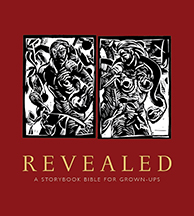 Ned himself did a workshop on print making there this weekend which gave him a chance to show off his own work as a print maker, some of which is seen in the adult Bible story book he created called Revealed: A Storybook Bible for Grown-Ups. (See our BookNotes description of it HERE.) We only wished we could have sent more books along, and that we could have joined Ned in talking with the participants there about our wares.
Ned himself did a workshop on print making there this weekend which gave him a chance to show off his own work as a print maker, some of which is seen in the adult Bible story book he created called Revealed: A Storybook Bible for Grown-Ups. (See our BookNotes description of it HERE.) We only wished we could have sent more books along, and that we could have joined Ned in talking with the participants there about our wares.
CIVA (Christians in the Visual Arts) is an exceptional organization for serious artists, art historians, museum curators, art teachers, theologians of culture, and those who teach aesthetics. As a non-church-related Christian organization it is perhaps parallel to CLS (the Christian Legal Society) which networks, encourages, and resources people of faith working in the legal profession, or, ASA, The American Scientific Affiliation, a good group for Christians who work in the sciences.
CIVA is world-class, world-renowned, and ecumenical (although with roots in the evangelical community, starting over 40 years ago when a sculptor and art prof at Bethel College organized the first gathering in 1979.) We have admired them from a far from the very beginning.
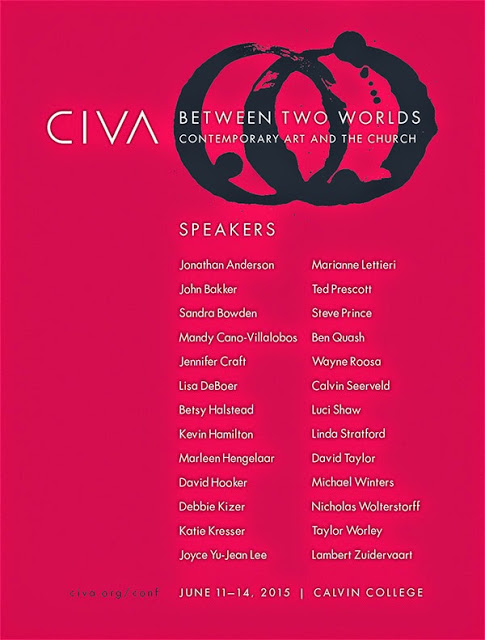 Two years ago the CIVA conference was held at Calvin College in Grand Rapids and the brand new book in their series “Studies in Theology and the Arts” is a wonderfully edited collection of papers, talks, and even panel discussions that were held at CIVA 2015. Entitled Contemporary Art and the Church: A Conversation Between Two Worlds, edited by W. David O. Taylor and Taylor Worley (IVP Academic; $30.00) it is nothing short of groundbreaking, stunning, and almost one of a kind. I’ll try to explain why.
Two years ago the CIVA conference was held at Calvin College in Grand Rapids and the brand new book in their series “Studies in Theology and the Arts” is a wonderfully edited collection of papers, talks, and even panel discussions that were held at CIVA 2015. Entitled Contemporary Art and the Church: A Conversation Between Two Worlds, edited by W. David O. Taylor and Taylor Worley (IVP Academic; $30.00) it is nothing short of groundbreaking, stunning, and almost one of a kind. I’ll try to explain why.
Unlike some other vocational fields, there are plenty of books about faith and the arts; we have shelves and shelves dedicated to this topic. We have books that are simple and basic – that everyone should read if you care about living a good life in God’s colorful world – and some that are heavy, heady, and wonderful for those who are serious artists or working in the world of scholarly and academic discourse in the arts. (You can see a few of our older annotated lists of such books HERE, HERE, HERE, HERE, or HERE. I did a review of Beauty Give By Grace: The Biblical Prints of Sadao Watanabe HERE.)
Even though I can hardly write my name with much flourish, let alone draw or paint or dance, I love these books and have found the breadth and depth of my own faith and Christian world-and-life view deepened by reading in this evocative field. I’ve often said that if I were to be stranded on the proverbial desert island and could only take one book, it would most likely be Calvin Seerveld’s Rainbows for the Fallen World. I know many in CIVA circles look to Cal as one of their great mentors.
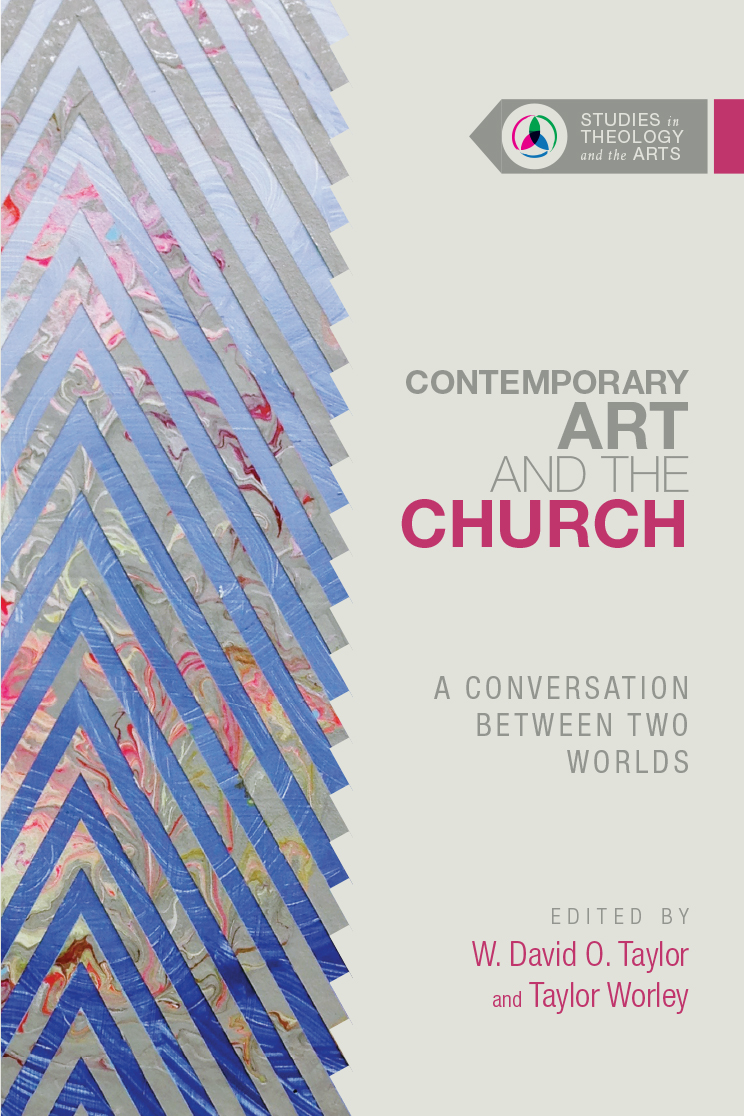 The brand new CIVA book takes the “faith and the arts” conversation deeper into what they call contemporary art (which is to say, not “modern” art which is a very specific style and movement which started over a 100 years ago.) Contemporary artists work most often in mixed media, video, performance, installation stuff, and their work is often transgressive. In the book’s excellent, rousing introduction it describes contemporary art as “artworks that employ narratives that feature marginal voices, transgressive activities, and the social and kinesthetic body. From Jeff Koons to Ai Weiwei, these artists, unlike their modernist precursors, “call on practices that generally exist in reaction to a perceived Western art canon.”
The brand new CIVA book takes the “faith and the arts” conversation deeper into what they call contemporary art (which is to say, not “modern” art which is a very specific style and movement which started over a 100 years ago.) Contemporary artists work most often in mixed media, video, performance, installation stuff, and their work is often transgressive. In the book’s excellent, rousing introduction it describes contemporary art as “artworks that employ narratives that feature marginal voices, transgressive activities, and the social and kinesthetic body. From Jeff Koons to Ai Weiwei, these artists, unlike their modernist precursors, “call on practices that generally exist in reaction to a perceived Western art canon.”
Not only is there serious engagement with this latest ethos within the art community, a second focus of Contemporary Art and the Church is, in fact, how the church might interact with the arts; that is, it explores significantly how artists these days might be more integrated into the life of local congregations and how local churches themselves might become more artful, aesthetically rich, creative. We have several great books about wisely discerning how to think about the arts in Christian worship; see, for instance the very thoughtful Visual Arts in the Worshiping Church by Lisa Deboer (Eerdmans; $24.00) or the more practically-minded Creative Church Handbook: Releasing the Power of the Arts in Your Congregation by J. Scott McElroy (IVP; $20.00.) Most of the papers presented at the CIVA conference that became chapters in this new book are pretty scholarly, even if they highlight great examples and case studies. It really is a remarkable volume.
In both the section in CAatC about Christian engagement with contemporary art and artists and the section about the church and worship, there were major keynote addresses and responses to those presentations. The responses are shorter but bring a different angle and offer very helpful conversation and much to ponder. I am really out of my own areas of expertise here, and had to take some of this fairly slowly, but it is just so very intriguing and good. Even if you’re not used to reading this sort of stuff about art history, a theology of culture, and the like, it is a very valuable education. And it’s so good just knowing that this level of discourse is going on. I think you could give this book to any college professor in the arts these days and they’d be impressed with the maturity of insight and the quality of scholarship.
Just for instance, in artist and scholar Wayne Roosa’s amazing chapter — his insights about the Old Testament prophets use of subversive performance art and naming some contemporary social prophets sent me to the internet to look up more, by the way — he explains the much-discussed On the Strange Place of Religion in Contemporary Art by the important, esteemed, critic James Elkins. (Mako Fujimura’s International Arts Movement, convened an IAM symposium on this text several years ago and we have stocked Elkins’s books ever since.) Roosa contrasted Elkins’s dour “not much conversation is possible” analysis with a more optimistic view found in Eleanor Heartney’s Postmodern Heretics: The Catholic Imagination in Contemporary Art. Along the way he draws in insights from Buber and Wittgenstein and Levinas, not to mention a stunning performance episode from Burning Man. What a chapter!
Linda Stratford (who coedited with James Romaine a book we carry called ReVisioning: Critical Methods for Seeing Christianity in the History of Art) in her shorter response called “Art and Spiritual Pilgrimage” shows that Roosa’s take on Elkins is more pessimistic than Elkins would have intended.
Her response is gracious, wonderfully expressed, and after a fascinating reflection on Andy Warhol she reminds us that:
It is time to cultivate a fruitful interplay between artists and today’s spiritual pilgrims. This requires that we adopt a posture more welcoming to the spiritual pilgrim, and in order to do that we must push back somewhat on Roosa’s contention that art and church are not a pair sharing “the same soil.” Both contemporary art and the church serve as arenas for contemplative awareness; both rely primarily on the revelatory power of expression; both serve as arenas for imaginative cultural change; and both serve as agents of social transformation. It is the nature of art that it discloses in an imaginative way; it is the nature of Christian faith that it is disclosed not only in a propositional set of beliefs but also in fresh, imaginative mode of questioning and searching… Transgressive art can serve the purpose of spiritual formation if we avoid the trap of labeling art “religious” or “not religious” and instead allow it to speak on its own terms.
Stratford captures much of the intent of the many authors in this book when she says:
With renewed lay and clerical training in our rich art heritage, and awareness of its generous theological breadth, we may indeed end up better equipped to invigorate the church’s missional posture. A renewed relationship between the church and the contemporary art world will have a wider impact than the dynamic between the two. Equipped with more richly informed, nuanced interaction with the contemporary art world, the church will find itself strengthened by adopting a posture more welcoming to the spiritual pilgrim than that of “The Church of the Ready-Made Definition.”
There is much in Taylor & Worley’s Contemporary Art and the Church: A Conversation Between Two Worlds for art enthusiasts, patrons, collectors. The chapter “Artists as Witnesses in the Church” by legendary art collector and CIVA co-founder Sandra Bowden and Marianne Lettieri shares their own stories of installing shows, loaning art, collaborating with art historians to get art pieces described well, and eventually creating the CIVA-funded book Seeing the Unseen: Launching and Managing a Church Gallery. What a lovely, lovely, chapter.
And, there is serious theology. The heady, obviously brilliant Ben Quash (Found Theology: History, Imagination and the Holy Spirit which was published the previous year by T & T Clark) was a big hit at the original conference and here his presentation is a major chapter that asks how contemporary art can be “devotional.” The respondent was the book coeditor Taylor Worley (who, by the way, has a PhD from University of St. Andrews and is associate professor of faith and culture as well as associate vice president for spiritual life and ministries at Trinity International University in Deerfield, Illinois. He himself is coeditor of Theology, Aesthetics, and Culture: Responses to the Work of David Brown.) Taylor’s reply to Quash is called “Graced Encounters.” Nice, eh?
Although some of it was pretty philosophical, I adored the chapter “Something from Nothing: A Theology of Nothingness and Silence for Yves Klein’s Le Vide” by Christina L. Carnes-Ananias. I had never heard of this seminal art experience, well described here, including a line about Albert Camus’s response when he attended the Le Vide show on April 28, 1958, which indicated how important it was and, I suppose, something about the driving spirit of much of this sort of work.
The section on worship is remarkably thoughtful and rich – Katie Dresser, whose PhD is from Harvard, and who teaches art at Seattle Pacific, has a great piece about the imago dei 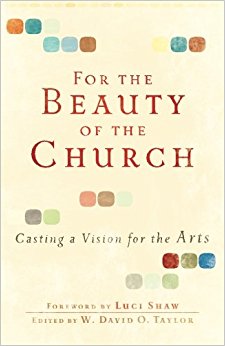 expressed in worship. W. David Taylor’s response (“What Art? Which Worship?”) is worth reading twice. You should know Taylor, by the way, as he compiled a wonderful little book for church folks interested in being more thoughtful and engaged in the arts called For the Beauty of the Church: Casting a Vision for the Art (Baker; $18.00.) He is an ordained Anglican minister and director of Fuller’s Brehm, Texas. (If some of this is new to you or your congregation, Taylor’s very approachable book includes great pieces by Eugene Peterson, Luci Shaw, Lauren Winner, Andy Crouch, John Witvliet, and Jeremy Begbie. It is the kind of book that I’d think every church should have in their church library or resource center.)
expressed in worship. W. David Taylor’s response (“What Art? Which Worship?”) is worth reading twice. You should know Taylor, by the way, as he compiled a wonderful little book for church folks interested in being more thoughtful and engaged in the arts called For the Beauty of the Church: Casting a Vision for the Art (Baker; $18.00.) He is an ordained Anglican minister and director of Fuller’s Brehm, Texas. (If some of this is new to you or your congregation, Taylor’s very approachable book includes great pieces by Eugene Peterson, Luci Shaw, Lauren Winner, Andy Crouch, John Witvliet, and Jeremy Begbie. It is the kind of book that I’d think every church should have in their church library or resource center.)
One chapter in Contemporary Art and the Church by Chelle Stearns called “(Con)Founded Theology” offers a “haptic pneumatology for contemporary art.” I didn’t know what that was either, so don’t worry.
And there’s a chapter by David W. McNutt with the subtitle “How Karl Barth’s Ecclesiology Can Help the Church Embrace Contemporary Art.” Right on!
One of my favorite chapters in the new CAatC book (again, academically rigorous as it is) is called “Art, Place, and the Church: Thinking Theologically About Contemporary Art in the Worship Space” by theologian Jennifer Allen Craft. She draws on The Poetics of Space by Gaston Bachelard and quotes Ricoeur and phenomenologist Merleu-Ponty, but most of us will be glad to see her footnotes including Wendell Berry and Brian Walsh and Walter Brueggemann’s The Land and that great book about an agrarian reading of the Bible by Ellen Davis. Any chapter that quotes Kunstler’s The Geography of Nowhere and relates it to worship should cause us to take notice, eh?
Please know that although there is a lot of academic footnotes and lots of allusions to what will be for most of us obscure artists and art shows, and there is philosophy and theology and liturgics and aesthetic theory that may not be your own native tongue, there is also lots of plain-spoken and truly inspiring calls to be seriously engaged in the world, to bear witness to the cosmic reconciliation where Christ is redeeming His hurting creation, and there is much that even those of us who aren’t involved in any art stuff will appreciate. In almost every chapter there is academic rigor and deep faith and testimony. There is history and cultural studies and there are stories and examples, which is to say that even those of us not schooled in this discourse will find most of this really fabulous, informative, helpful.
A true highlight of the book for me was a lively panel discussion on the history, struggles and future of CIVA where philosopher Nicholas Wolterstorff (his book Art in Action remains a standard) invited four key figures to ruminate together. And what a joy to listen in on such a candid symposium of remembrance and hope. In this chapter you get the verbatim from Sandra Bowden, Ted Prescott, Calvin Seerveld and Marleen Hengelaar-Rookmaaker. I have to admit I hadn’t anticipated having Hearts & Minds named as a sign of hope in these matters, and it made my eyes moist with encouragement. Maybe it is just me, but I think for any of us who are leaders, social activists, agents of change, founders of organizations of any sort, hearing the stories of these good folks who felt so marginalized and misunderstood within their churches and religious institutions was moving and good. Learning how they banded together to work in this particular field in God’s Kingdom is inspiring and instructional. (I am sure that scientists and lawyers, just for instance, could tell similar stories of needing to band together for like-minded fellowship and mutual encouragement.) I simply have to praise God for this kind of stuff, knowing of the sacrifices and innovative leadership offered in this arena.
There was another symposium/panel discussion at CIVA that year, and it, too, made its way into the book. It is a wonderfully informative set of stories by those practicing art making in these days. Moderated by the very active new media artist and scholar Kevin Hamilton, we get to listen in on this conversation by serious artists talking about their wok in the public square. For anyone in the church who is interested in supporting various careers and callings, this is a glimpse into the lives of artists that is well worth pay attention to.
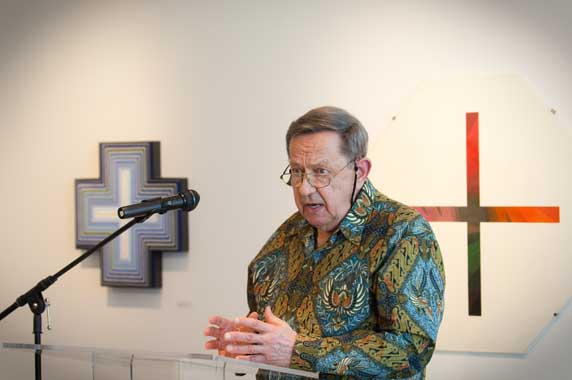 And I must say this: I got choked up reading the vivid Biblical insights of Calvin Seerveld in a brilliant chapter near the end called “Helping Your Neighbor See Surprises: Advice to Recent Graduates.” As one who edited a collection of inspiring, visionary commencement addresses helping young graduates (Serious Dreams: Bold Ideas for the Rest of Your Life, nicely published by Square Halo Books) I am particularly interested in the sorts of advice given to those moving into the professional spheres of their lives. Seerveld is speaking to those with art degrees, of course, but I was still so taken with it I read it twice. He offers plenty of fresh insights, including about the hard work it takes to master a craft (“it takes almost monastic focus to achieve the technical competence basic to good artwork”) but also how we ought not allow our multi-dimensional human life to be swallowed up by being an artist.” This is a profound insight into the nature of things:
And I must say this: I got choked up reading the vivid Biblical insights of Calvin Seerveld in a brilliant chapter near the end called “Helping Your Neighbor See Surprises: Advice to Recent Graduates.” As one who edited a collection of inspiring, visionary commencement addresses helping young graduates (Serious Dreams: Bold Ideas for the Rest of Your Life, nicely published by Square Halo Books) I am particularly interested in the sorts of advice given to those moving into the professional spheres of their lives. Seerveld is speaking to those with art degrees, of course, but I was still so taken with it I read it twice. He offers plenty of fresh insights, including about the hard work it takes to master a craft (“it takes almost monastic focus to achieve the technical competence basic to good artwork”) but also how we ought not allow our multi-dimensional human life to be swallowed up by being an artist.” This is a profound insight into the nature of things:
You are essentially the same person even if you are both a priest and a husband – but you should not wear sacerdotal robes when you sleep with your wife in bed. You may be both a mother and a first rate lawyer, but if you treat your home like a prison and the children as if they are on parole, the resulting distortion bodes trouble. Likewise, when it comes time to pay the bills, it is not right to say, “Sorry, but I’m an artist!” A person is never just or wholly an artist but always an artist and a citizen, a mystic, a hypochondriac, an intelligent person and so on…
Few have done more to write academically and Biblically about the arts and aesthetics than Cal Seerveld. (See my review of a six volume set of books of his, here.) Of course, he is always clever and a bit playful (he says that “artistry is making merry with metaphor.”) But it takes a certain sort of chutzpah, or humble confidence in being an older brother to many, to remind a gathering of artists not to call themselves artists. What?
And, not to overstate the role of the arts, either, blessed as it may be. Seerveld writes,
It is also important to realize that the artistic responsibility to be imaginative is limited. The imaginative task is to arouse the twinkle of hope in your neighbor, and not, for example, to solve the societal disaster of widespread poverty.
After movingly describing two passionate paintings that he surely showed on slides, about degradation and brokenness in the world, Seerveld insists that visual artwork that is normative and fulfills its limited creaturely task doesn’t have to preach the gospel or change the world.
God wants art to do subtle justice to what is good and bad in reality, and serve it up with a sparkle of colorful grace and a wink of mercy. Your artwork does not and cannot have to do everything you have the capacity for, but its limited offering can be a cover for thanking God.
As is typical with Seerveld’s sort of reformational worldview, influenced by the neo-Calvinist all-of-life-redeemed vision of Abraham Kuyper, he preaches a bit about the reality of the Kingdom of God that encompasses all societal spheres. (Even in the panel discussion he kindly expressed a hint of frustration that CIVA was talking about “the church” and “theology” (two topics he knows a lot about and cares for deeply) as if that is what makes good art useful for Christians. Christians with a robust vision of vocation will serve God in their work whether it is related to the institutional church or not, since the reign of God is creation-wide and not limited to the congregation as such. After some excited reminders of God’s reconciling, restoring work in the world, he reminds us, then, how art can contribute to the coming of the city of God. Even if you know a lot about the arts, you should buy this book to read what Seerveld nicely says about “jesters and ventriloquists” on pages 215-216. It was a great compliment to CIVA members old and new, and to all of us reading along in this important volume, to be called such things by Seerveld. I will be pondering this new description of my own calling for quite some time.
The book ends with another truly exceptional chapter, a wonderful, informed, significant, and beautiful message by CIVA Executive Director Cameron Anderson. It is called “Saving the World” and it offers much wisdom and insight for us all.
Anderson explains his goal:
In this closing essay I invite you to consider how all that is rich and good in our respective cultural arenas, the artistic and the ecclesial, might be directed to love God and neighbor more completely.
Cam quotes John Chrysostom on I Corinthians 1: 18 about the role of the weak and misunderstood, perhaps the foolhardy saints now known as contemporary artists. Wow.
 And he explores the often-cited line from Solzhenitsyn and Dostoevsky that “beauty can save the world.” I needn’t here recount the scholars and writers Anderson cites in his brief overview of the role of beauty in our lives, but he does hang out a bit with C.S. Lewis. This is good, rich, stuff, and it must have been a joy and invigorating to hear this talk live. It is well worth reading, well worth pondering, good for any of us. I know it will be a stretch for some, but I highly recommend Contemporary Art and the Church: A Conversation Between Two Worlds, edited by W. David O. Taylor and Taylor Worley. It’s important.
And he explores the often-cited line from Solzhenitsyn and Dostoevsky that “beauty can save the world.” I needn’t here recount the scholars and writers Anderson cites in his brief overview of the role of beauty in our lives, but he does hang out a bit with C.S. Lewis. This is good, rich, stuff, and it must have been a joy and invigorating to hear this talk live. It is well worth reading, well worth pondering, good for any of us. I know it will be a stretch for some, but I highly recommend Contemporary Art and the Church: A Conversation Between Two Worlds, edited by W. David O. Taylor and Taylor Worley. It’s important.
I couldn’t quite work this in earlier, but there included in the book are some full color photographs nicely reproduced showing a handful of pieces done by some of the CIVA participants, such as Bruce Herman, Tim Lowly, Karen Brummund, Marianne Lettieri, Erica Grimm, Roger Feldman, Joyce Yu-Jean Lee, David Hooker, Jay Walker, Phaedra Taylor, Allison Luce, Scott Erickson, Many Cano Villalobos, Steve A. Prince, and Ted Prescott. These are done on glossy paper as an insert in the book and illustrate some very allusive, interesting, creative pieces.
TWO MORE
There have been two previous books in the CIVA “Studies in Theology and the Arts.”
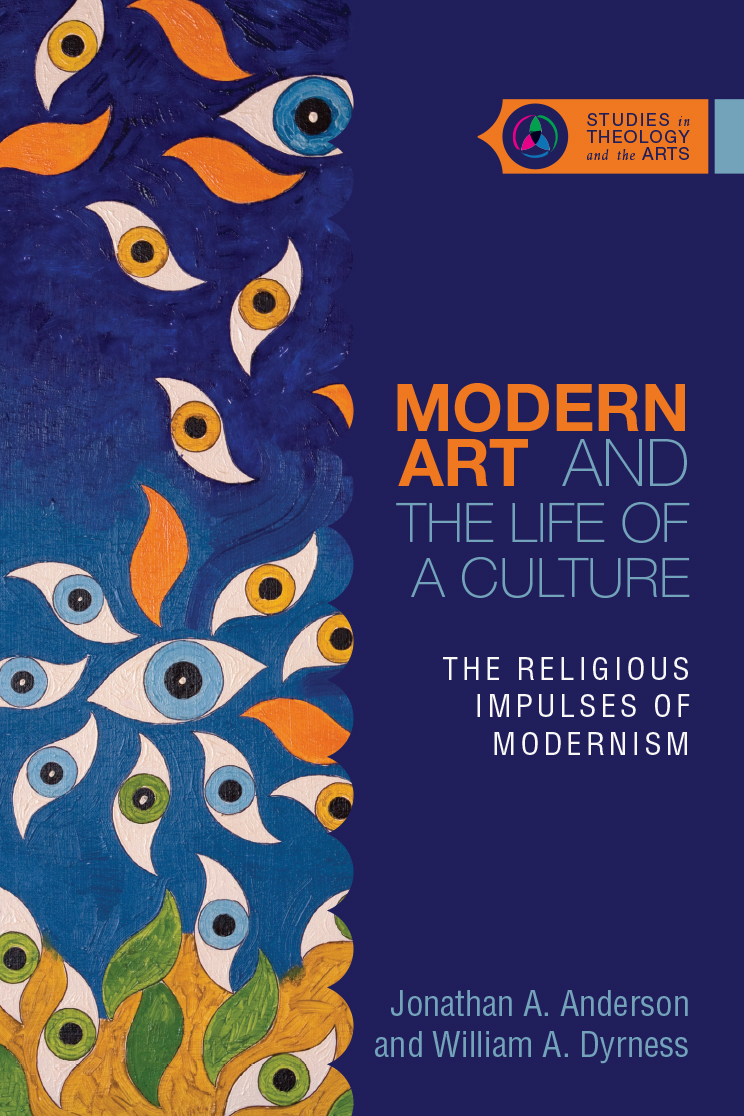 Modern Art and the Life of a Culture: The Religious Impulses of Modernism by Jonathan A. Anderson and William A. Dyrness (IVP Academic) $24.00 This book was a bit controversial when it released about a year ago; it offers a long-awaited and some think much-needed discussion about the problems — at least according to these authors — of the 1970s classic Rookmaaker volume Modern Art and the Death of a Culture. Jonathan Anderson, by the way, has a major chapter in the new one, too, and is a very significant scholar. And William Dryness has bunches of other books that we stock. He’s a vital, prolific author who spoke this week at CIVA 2017. This book is a truly major contribution to the conversation about faith as it is seen within modern and contemporary art and along with books by Daniel Siedell (God in the Gallery:A Christian Embrace of Modern Art and Whose Afraid of Modern Art?) represent a major new level of discourse about Christian engagement in the 21st century art scene. We commend it for your consideration. See my review of it HERE.
Modern Art and the Life of a Culture: The Religious Impulses of Modernism by Jonathan A. Anderson and William A. Dyrness (IVP Academic) $24.00 This book was a bit controversial when it released about a year ago; it offers a long-awaited and some think much-needed discussion about the problems — at least according to these authors — of the 1970s classic Rookmaaker volume Modern Art and the Death of a Culture. Jonathan Anderson, by the way, has a major chapter in the new one, too, and is a very significant scholar. And William Dryness has bunches of other books that we stock. He’s a vital, prolific author who spoke this week at CIVA 2017. This book is a truly major contribution to the conversation about faith as it is seen within modern and contemporary art and along with books by Daniel Siedell (God in the Gallery:A Christian Embrace of Modern Art and Whose Afraid of Modern Art?) represent a major new level of discourse about Christian engagement in the 21st century art scene. We commend it for your consideration. See my review of it HERE.
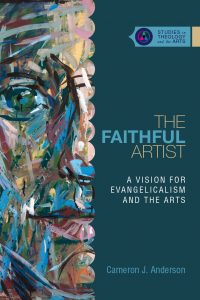 The Faithful Artist: A Vision for Evangelicalism and the Arts by Cameron J. Anderson (IVP Academic) $26.00. I mentioned earlier that Cam has a wonderful chapter in the new one. He has worked in campus ministry with faculty and grad students, has his own MFA and is now the Executive Director of Christians in the Visual Arts. This one was the second release in this impressive new CIVA-related series and, again, I cannot say enough about it. I discussed it a bit at BookNotes when it first released and I only wish I had the expertise to give it its due. We respect Cam and his work very much and this book is very highly recommended. We’ve mentioned The Faithful Artist several times in our BookNotes newsletters (including naming it among our “Best Books of 2016” listings) but I find this review by our friend Bob Trupe to be helpful in explaining it. Check out his review HERE (but come back and order it from us, as Bob himself nicely suggests.)
The Faithful Artist: A Vision for Evangelicalism and the Arts by Cameron J. Anderson (IVP Academic) $26.00. I mentioned earlier that Cam has a wonderful chapter in the new one. He has worked in campus ministry with faculty and grad students, has his own MFA and is now the Executive Director of Christians in the Visual Arts. This one was the second release in this impressive new CIVA-related series and, again, I cannot say enough about it. I discussed it a bit at BookNotes when it first released and I only wish I had the expertise to give it its due. We respect Cam and his work very much and this book is very highly recommended. We’ve mentioned The Faithful Artist several times in our BookNotes newsletters (including naming it among our “Best Books of 2016” listings) but I find this review by our friend Bob Trupe to be helpful in explaining it. Check out his review HERE (but come back and order it from us, as Bob himself nicely suggests.)
We are grateful for the chance to sell these kinds of books and hope that if you know anyone who might find this useful that you would alert them – or, better yet, buy a book or two for them. Not many bookstores carry this kind of stuff, and we would be please to play a small part in your efforts to encourage others for whom these kinds of books could be a lifeline.
BookNotes
DISCOUNT
ANY ITEM MENTIONED
10% off
order here
takes you to the secure Hearts & Minds order form page
just tell us what you want
inquire here
if you have questions or need more information
just ask us what you want to know
Hearts & Minds 234 East Main Street Dallastown, PA 17313
read@heartsandmindsbooks.com
717-246-3333
